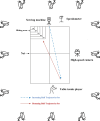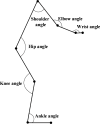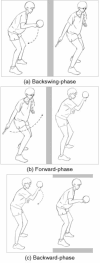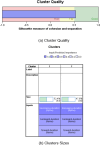Research on the difference of stroke characteristics and stroke effect between different stroke duration of table tennis players
- PMID: 39455840
- PMCID: PMC11511840
- DOI: 10.1038/s41598-024-76802-2
Research on the difference of stroke characteristics and stroke effect between different stroke duration of table tennis players
Abstract
This study aimed to explore the differences in joint kinematic characteristics and stroke effect between fast and slow strokes of table tennis players. Thirty-four table tennis players were randomly selected as participants for this experiment. A high-speed infrared motion capture system was used to collect kinematic data of the right-side upper and lower limb joints during strokes. Simultaneously, a high-speed camera was used to measure the stroke effect. According to the duration of a stroke, the stroke data were classified into two types: fast-stroke and slow-stroke using a two-step clustering algorithm. The duration of the three phases of fast-stroke was shorter, with faster ball speed and stronger spin. Compared with slow-stroke, fast-stroke exhibited shorter displacements in the three lower limb joints and faster linear velocities in the three upper limb joints. In addition, the motion angles of the knee and ankle joints were smaller, while the angles of the hip, shoulder, and elbow joints were larger, with higher angular velocities. Increasing the extension speed of the lower limbs, the flexion speed of the elbow joints, and the wrist movement speed can achieve fast strokes, enhancing ball speed and spin. Small and quick hip joint movement can effectively transfer energy to the upper limbs, increasing the movement speed of the elbow and wrist joints, thus improving the ball speed and spin of the stroke.
Keywords: Fast-stroke; Kinematic characteristics; Slow-stroke; Stroke effect; Table tennis.
© 2024. The Author(s).
Conflict of interest statement
The authors declare no competing interests.
Figures







References
-
- Iino, Y. & Kojima, T. Kinetics of the upper limb during table tennis topspin forehands in advanced and intermediate players. Sports Biomech.10(4), 361–377. 10.1080/14763141.2011.629304 (2011). - PubMed
-
- Samuel, R., Baptiste, M., Damien, S. & Christophe, H. Influence of fatigue on upper limb muscle activity and performance in tennis. J. Electromyogr. Kinesiol.24(1), 90–97. 10.1016/j.jelekin.2013.10.007 (2014). - PubMed
-
- Bańkosz, Z. & Winiarski, S. The kinematics of table tennis racquet: Differences between topspin strokes. J. Sports Med. Phys. Fitness57(3), 202–213. 10.23736/s0022-4707.16.06104-1 (2017). - PubMed
-
- Mansec, Y. L., Dorel, S., Nordez, A. & Jubeau, M. Sensitivity and reliability of a specific test of stroke performance in table tennis. Int. J. Sports Physiol. Perform.11(5), 678. 10.1123/ijspp.2015-0444 (2015). - PubMed
MeSH terms
Grants and funding
LinkOut - more resources
Full Text Sources

